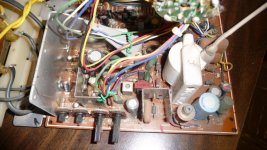The key question is whether the entire raster moves vertically (bobs) or the picture information in the raster bobs. Its not possible to see this in your video as the brightness is not high enough to see the raster, only the video information/image.
In the first case, if is a raster disturbance, there is a problem in the monitor where a small shift in the vertical scanning current is occurring in the vertical deflection amplifier altering the raster position or amplitude.The overall vertical scanning amplitude is set by the Height control, so rotate that a few times in case the potentiometer has gone noisy. A power supply glitch/noise/error would cause a disturbance, or a failing component. The vertical scanning current is fairly high at its peak and resistance in plug connections to the vertical yoke coils on oxidized connectors can cause problems, intermittent or poor solder joins etc. If that was happening the cause could be fairly easily found with a scope.
In the second case if it is the video information bobbing up an down in the scanning raster, it is a relative vertical sync timing issue (the signal you are feeding it) with respect to the vertical scan oscillator frequency in the monitor. So either of these has an issue. If you feed the video signal into another test monitor (or check it on a scope) and the bobbing is not there, then it is a timing (intermittent vertical scan oscillator frequency shift) issue in the monitor, probably.
The vertical scan frequency in the monitor is controlled by a preset potentiometer called "Vertical Hold". It could possibly be a noisy potentiometer so rotate it a few times. However it could be a circuit component or power supply issue.It would be fairly easy to track it down with a scope.
When the vertical hold is set properly, the free running frequency of the oscillator is set just a little slower than the vertical sync rate, and in the moments just before vertical lock, the image on the screen should have a black blanking bar, rolling upwards a little, before it appears to roll out of view at the top and vertical lock is achieved.
Find another video source known to be normal, feed that to the monitor to confirm the problem resides in the monitor and not the signal you are feeding it with.
Post another video with higher brightness and reduced Height, so the top and bottom (beginning and end of the vertical component of the scanning raster) is visible to confirm whether it is the raster or the image in it, that is moving. In a nutshell, initially rotate the vertical height and hold controls to exercise them and see if there is any improvement with the problem.


